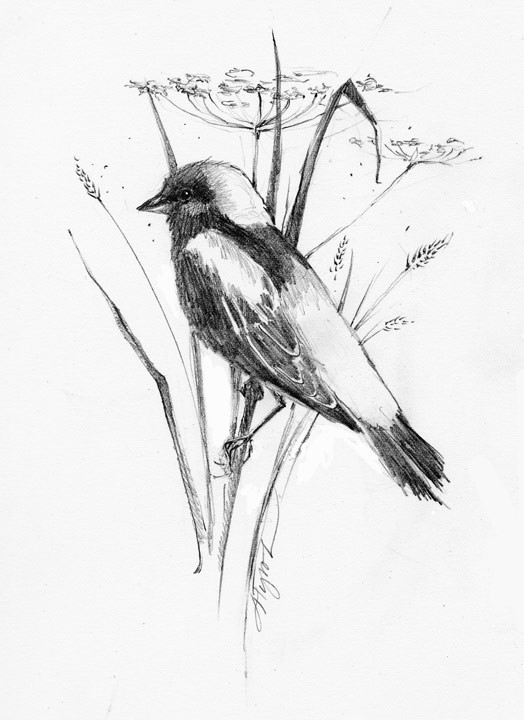
To birders and meadow-walkers alike, the bubbling, exuberant song of the bobolink is one of summer’s highlights. Singing as it swoops over grasses, this black bird with a yellow cap, white wing stripes, and white rump is the quintessential spirit of New England’s fields.
On top of their singing talents, these birds are extraordinary migrators. Bobolinks have the longest migration route of all New World land birds. Come fall, they depart our fields and fly to far distant destinations in the South American pampas, a grassland stretching from southern Brazil through Uruguay to northern Argentina.
Rosalind Renfrew, a bobolink researcher at Vermont Center for Ecostudies in Norwich, Vermont, reported on a bobolink she had fitted with a leg band while on field work in Bolivia. Three years later, the leg band was retrieved when this bird was killed by a cat in Chelsea, Vermont, some 4,300 miles from where it had been banded. In the intervening time, it must have flown at least 35,000 miles in migration.
This ability to navigate over such immense distances has awed bird enthusiasts and sparked scientific inquiry. Like other migrating songbirds, bobolinks fly at night to avoid predatory hawks, so they don’t rely on the sun for navigation. Could birds be using the constellations, just as human navigators have learned to do?
Indeed, studies conducted in planetariums show that bobolinks align their migration direction according to stellar clues. When the artificial stars were rotated, the bobolinks took note. However, when a magnetic field was applied in the planetarium at the same strength as the earth’s magnetic field but in the reverse direction, the bobolinks changed course 180 degrees, even though the artificial constellations had not moved. Evidently the birds were orienting using magnetism as well as stars.
Bobolink brains have evolved with built-in magnets. Anatomical studies on bobolinks’ heads reveal deposits of iron oxide around the olfactory nerve and the olfactory bulb (the ‘smell’ organ) and even in bristles projecting into the nasal cavity. Closely proximal nerves fire in response to small changes in magnetism to provide the exquisite sensitivity necessary for navigation by the earth’s magnetic field. Bobolinks use magnetism as their primary navigational tool and then rely on the stars once their internal compass bearing has been set.
Just as astonishing is the observation that female bobolinks return faithfully to the same breeding meadow each year, showing that the birds also memorize local landmarks.
Despite such prodigious abilities, bobolink numbers have been declining over the past several decades. Navigating local hay fields, it seems, can be just as hazardous as navigating between continents.
Bobolinks were originally summer inhabitants of the Midwestern prairie, though they shifted eastward as agriculture reshaped the landscape. As a result, bobolinks now depend on man-made fields for foraging and nesting, preferring grasses mixed with weeds like red clover and dandelion. They also require large grassy expanses, minimally 10 acres, but optimally 100 acres or more.
The male bobolink arrives in New Hampshire and Vermont in early May. About a week later, the female arrives and sets to work making her cup-like nest of grass on the ground, concealed beneath broad-leaved growth. She starts brooding her eggs towards the end of May, and in about 12 days, the chicks hatch. It takes a further 11 or so days of frenzied feeding by the parents before the young leave the nest in late June. A subset of bobolinks then proceed to raise a second brood that will remain in the fields until late in July.
If hay is cut during this interval, nests and nestlings will be destroyed. The first hay hereabouts is traditionally cut around Memorial Day. Provided they can find cover, bobolinks can re-nest in two weeks if their first nest is destroyed. However, intensive haying often involves a second and even third cutting, leaving no window for successful breeding.
So here’s the paradox for the bobolink: hay fields are both essential and dangerous for their survival.
Landowners who don’t need high-protein, first-cut hay, such as horse owners and those who wish only to keep their fields open, can help bobolinks out by delaying all cutting until late July. A second option is to allow two full months between the first and second cut, allowing enough time for successful re-nesting.
Delayed mowing benefits more than just bobolinks. Three endangered birds, Henslow’s sparrow, sedge wren, and upland sandpiper, and the threatened meadow lark, grasshopper sparrow, and savannah sparrow, all benefit from favorable management of grassy fields. If you can, give them a hand by only mowing later in the summer.


Discussion *